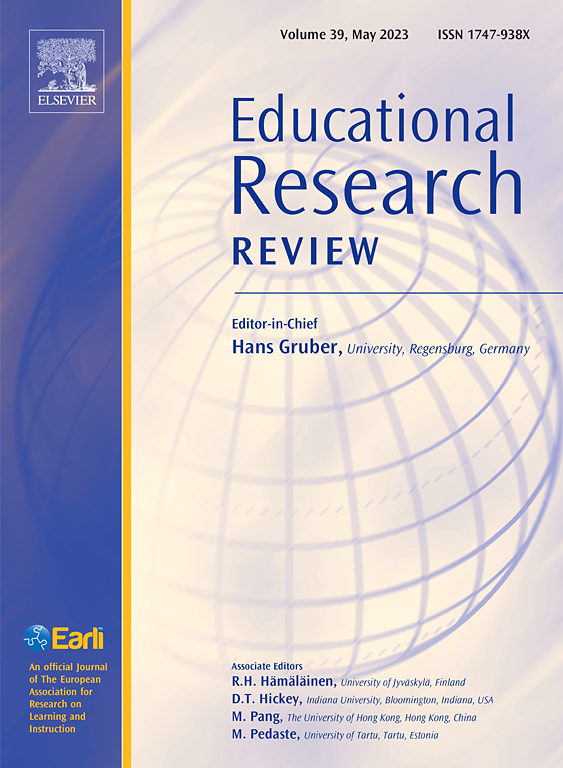Technology-enhanced content and language integrated learning: A systematic review of empirical studies
IF 10.6
1区 教育学
Q1 EDUCATION & EDUCATIONAL RESEARCH
引用次数: 0
Abstract
Content and language integrated learning (CLIL), i.e., learning subject content in a non-native language, has been widely promoted as an innovative way of teaching English as a foreign language. More recently, technology is integrated in CLIL programs. In view of the growing number of studies on technology-enhanced CLIL (TECLIL) and the limitations of previous reviews in this field, this paper presents a systematic review of empirical studies on TECLIL. Based on the findings from 20 articles published in Social Science Citation Index (SSCI) journals (2014–2023), this review summarizes the key characteristics of the empirical studies on TECLIL, the types of technology applied in TECLIL programs, the learning outcomes reported in TECLIL studies, and exemplary cases demonstrating the design and implementation of TECLIL in practice. Seven types of technology applied in TECLIL programs are identified. Telecollaboration tools are the most frequently used, followed by online learning platforms, multimedia, virtual learning environments, social network applications, language tools, and intelligent conversation tools. The language skills explored in TECLIL programs focus on productive skills (e.g., speaking and writing) rather than receptive skills (e.g., listening and reading). Cognitive learning outcomes in terms of subject knowledge and language skills are commonly assessed in TECLIL studies, with less attention to affective outcomes. Overall, the use of technology has yielded a small effect (effect size = 0.29) on content knowledge acquisition, but no substantial effect (effect size = 0.16) on language achievement. Although there is a growing body of research on TECLIL, more empirical studies are needed to determine effective design of TECLIL programs and the effects of TECLIL on both cognitive and affective outcomes.
技术增强的内容与语言整合学习:实证研究的系统回顾
内容与语言整合学习(CLIL),即用非母语学习学科内容,作为一种创新的英语教学方式得到了广泛的推广。最近,技术被集成到CLIL程序中。鉴于对技术增强型CLIL (TECLIL)的研究越来越多,以及以往研究的局限性,本文对TECLIL的实证研究进行了系统综述。本文基于2014-2023年发表在SSCI期刊上的20篇论文,总结了TECLIL实证研究的主要特征、TECLIL项目中应用的技术类型、TECLIL研究中报告的学习成果以及TECLIL在实践中设计和实施的典型案例。确定了TECLIL程序中应用的七种技术。使用频率最高的是远程协作工具,其次是在线学习平台、多媒体、虚拟学习环境、社交网络应用、语言工具和智能会话工具。在TECLIL课程中探索的语言技能侧重于生产技能(例如,口语和写作)而不是接受技能(例如,听力和阅读)。在TECLIL研究中,通常评估学科知识和语言技能方面的认知学习结果,而较少关注情感结果。总体而言,技术的使用对内容知识的获取产生了较小的影响(效应量= 0.29),但对语言成就没有实质性影响(效应量= 0.16)。尽管对TECLIL的研究越来越多,但需要更多的实证研究来确定TECLIL程序的有效设计以及TECLIL对认知和情感结果的影响。
本文章由计算机程序翻译,如有差异,请以英文原文为准。
求助全文
约1分钟内获得全文
求助全文
来源期刊

Educational Research Review
EDUCATION & EDUCATIONAL RESEARCH-
CiteScore
19.40
自引率
0.90%
发文量
53
审稿时长
57 days
期刊介绍:
Educational Research Review is an international journal catering to researchers and diverse agencies keen on reviewing studies and theoretical papers in education at any level. The journal welcomes high-quality articles that address educational research problems through a review approach, encompassing thematic or methodological reviews and meta-analyses. With an inclusive scope, the journal does not limit itself to any specific age range and invites articles across various settings where learning and education take place, such as schools, corporate training, and both formal and informal educational environments.
 求助内容:
求助内容: 应助结果提醒方式:
应助结果提醒方式:


